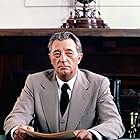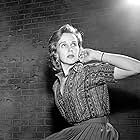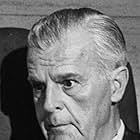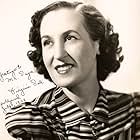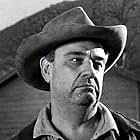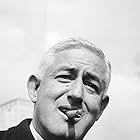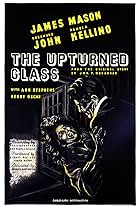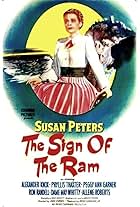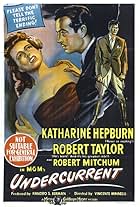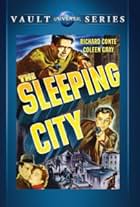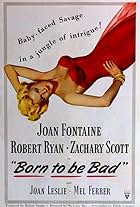VALUTAZIONE IMDb
6,5/10
1420
LA TUA VALUTAZIONE
Un'ingenua ragazza di provincia arriva a New York per incontrare suo marito e scopre che potrebbe essere un assassino.Un'ingenua ragazza di provincia arriva a New York per incontrare suo marito e scopre che potrebbe essere un assassino.Un'ingenua ragazza di provincia arriva a New York per incontrare suo marito e scopre che potrebbe essere un assassino.
Robert Mitchum
- Fred Graham
- (as Bob Mitchum)
Milton Kibbee
- Charlie
- (as Milt Kibbee)
Lee 'Lasses' White
- Old Man
- (as Lee White)
Fred Aldrich
- Police Detective
- (non citato nei titoli originali)
Lennie Bluett
- Dancer at Big Jims
- (non citato nei titoli originali)
Marie Bryant
- Dancer in Big Jims
- (non citato nei titoli originali)
William Castle
- Man in Photograph Given to Police.
- (non citato nei titoli originali)
Trama
Lo sapevi?
- QuizThe cast credits in the original release are just the same as they appear on IMDb, with Dean Jagger in first position, Robert Mitchum in third position, and Rhonda Fleming uncredited. When the film was retitled and re-released in 1949, Jagger's and Mitchum's positions were reversed, with Mitchum now in first position and Jagger in third position. Uncredited Fleming, who only appears in the final episode aboard the train, is now prominently included among the leading players in the closing credits. This is the version most frequently shown on cable TV on Turner Classic Movies.
- BlooperIn the movie, the famous Bleecker Street of Manhattan's Greenwich Village is misspelled as Bleeker.
- ConnessioniFeatured in Stars of the Silver Screen: Robert Mitchum (2013)
- Colonne sonoreBoogie Woogie
(uncredited)
Music by Lorenzo Flennoy
Recensione in evidenza
Castle's third feature is an interesting case of talents in the bud. Previously he had been responsible for a bright Boston Blackie series entry with Chester Morris, and the less successful Klondike Kate (1943) with Tom Neal. When Strangers Marry (also known by the less accurate title of Betrayed) shows the director's increasing confidence as he ventures into the territory of the new film noir genre. He was also lucky in securing the services of a good cast: Kim Hunter, Dean Jagger and, in his first co-starring role, a young Robert Mitchum. One of the greatest noir stars, Mitchum is slimmer and perhaps more tentative here than he would be in later films, but still has enough presence and skill to make an impact, especially in the sweaty closing scenes. Already an experienced hand, Dimitri Tiomkin provided the music, and the result was an above average production from Monogram.
Having said that, there's a certain peremptoriness to the film, making it not entirely satisfactory. The noir style, which thrived on inexpensive sets and the economic use of shadow, cheap location shooting and the like, is evoked by Castle rather than expressed in any thorough fashion. Castle's next film The Whistler (1944), on yet another miniscule budget, was much more effective in evoking a continuous mood of paranoia and doom from the haunted Richard Dix. Some successful scenes apart, (Millie's first night in the hotel, her Lewtonish night walk, her innocent suspicions in Paul's apartment), the present film rather clumsily bolts noir elements on to a standard suspense plot - one vaguely reminiscent of Hitchcock's Suspicion of three years before - rather than to let them arise naturally from situation and character. An example is Millie's night of disturbed rest in the hotel. Husbandless in her neon sign-lit room, drowned in shadows and fear, she is distracted by the repeated blaring of nearby dancehall before taking a fraught phone call from Fred (Mitchum). This scene has no real plot purpose except to show her loneliness and distress, and the expressionist images seem over emphatic. On its own it is startling and dramatic, but nothing more, a pool of hard noir in a more naturalistic film. Even less convincingly, as if it had never happened Millie then makes no move to change her room later the next day, and the music never occurs again (it would have made an excellent punctuation for any later confrontation with Fred, for instance). As an actress, Kim Hunter makes an effective noir victim, even if her trusting fragility needs a willing suspension of disbelief. Powell and Pressburger obviously recognised such sensitivity even in a poverty row product like this, for they shortly cast her in such films as A Canterbury Tale, of the same year, and then in A Matter of Life and Death (1946).
A more serious plot flaw resides in the character of her husband Paul (Jagger). His personality and motives are shrouded in mystery throughout the film and, sadly, are not much clearer by the end. For a while this enigmatic man provides the narrative with a lot of useful suspense. The lack of resolution to his drama, while supplying the necessary twist as the truth is revealed, leaves the viewer with just too many questions to be comfortable. One misses even the rudimentary psycho-analysis which appeared in some noirs from this time, supposedly explaining the aberrant personality. Either elements of helpful exposition were jettisoned in the course of filming on a tight budget, or the writers (who included the excellent Philip Jordan, of Dillinger, Detective Story, Big Combo fame) thought they could get away with such a lacuna. The result is to reduce a happy ending to one where a married couple must still live on unresolved tensions, their determined contentment notwithstanding.
For those interested in trivia there are some private jokes in the film. A 'Mr King' is paged at the hotel (the film was produced by the King brothers). More amusingly, Millie hands over a deliberately misleading picture to the investigating detectives, saying 'This is the man you want'. It is director Castle. Such gallows humour, and self-publicity, would manifest itself in a series of gimmick films for which he is better known, starting in the 50's...
Having said that, there's a certain peremptoriness to the film, making it not entirely satisfactory. The noir style, which thrived on inexpensive sets and the economic use of shadow, cheap location shooting and the like, is evoked by Castle rather than expressed in any thorough fashion. Castle's next film The Whistler (1944), on yet another miniscule budget, was much more effective in evoking a continuous mood of paranoia and doom from the haunted Richard Dix. Some successful scenes apart, (Millie's first night in the hotel, her Lewtonish night walk, her innocent suspicions in Paul's apartment), the present film rather clumsily bolts noir elements on to a standard suspense plot - one vaguely reminiscent of Hitchcock's Suspicion of three years before - rather than to let them arise naturally from situation and character. An example is Millie's night of disturbed rest in the hotel. Husbandless in her neon sign-lit room, drowned in shadows and fear, she is distracted by the repeated blaring of nearby dancehall before taking a fraught phone call from Fred (Mitchum). This scene has no real plot purpose except to show her loneliness and distress, and the expressionist images seem over emphatic. On its own it is startling and dramatic, but nothing more, a pool of hard noir in a more naturalistic film. Even less convincingly, as if it had never happened Millie then makes no move to change her room later the next day, and the music never occurs again (it would have made an excellent punctuation for any later confrontation with Fred, for instance). As an actress, Kim Hunter makes an effective noir victim, even if her trusting fragility needs a willing suspension of disbelief. Powell and Pressburger obviously recognised such sensitivity even in a poverty row product like this, for they shortly cast her in such films as A Canterbury Tale, of the same year, and then in A Matter of Life and Death (1946).
A more serious plot flaw resides in the character of her husband Paul (Jagger). His personality and motives are shrouded in mystery throughout the film and, sadly, are not much clearer by the end. For a while this enigmatic man provides the narrative with a lot of useful suspense. The lack of resolution to his drama, while supplying the necessary twist as the truth is revealed, leaves the viewer with just too many questions to be comfortable. One misses even the rudimentary psycho-analysis which appeared in some noirs from this time, supposedly explaining the aberrant personality. Either elements of helpful exposition were jettisoned in the course of filming on a tight budget, or the writers (who included the excellent Philip Jordan, of Dillinger, Detective Story, Big Combo fame) thought they could get away with such a lacuna. The result is to reduce a happy ending to one where a married couple must still live on unresolved tensions, their determined contentment notwithstanding.
For those interested in trivia there are some private jokes in the film. A 'Mr King' is paged at the hotel (the film was produced by the King brothers). More amusingly, Millie hands over a deliberately misleading picture to the investigating detectives, saying 'This is the man you want'. It is director Castle. Such gallows humour, and self-publicity, would manifest itself in a series of gimmick films for which he is better known, starting in the 50's...
- FilmFlaneur
- 15 set 2002
- Permalink
I più visti
Accedi per valutare e creare un elenco di titoli salvati per ottenere consigli personalizzati
- How long is When Strangers Marry?Powered by Alexa
Dettagli
- Data di uscita
- Paese di origine
- Lingua
- Celebre anche come
- When Strangers Marry
- Azienda produttrice
- Vedi altri crediti dell’azienda su IMDbPro
Botteghino
- Budget
- 50.000 USD (previsto)
- Tempo di esecuzione1 ora 7 minuti
- Colore
- Proporzioni
- 1.37 : 1
Contribuisci a questa pagina
Suggerisci una modifica o aggiungi i contenuti mancanti

Divario superiore
By what name was Notte d'angoscia (1944) officially released in India in English?
Rispondi







